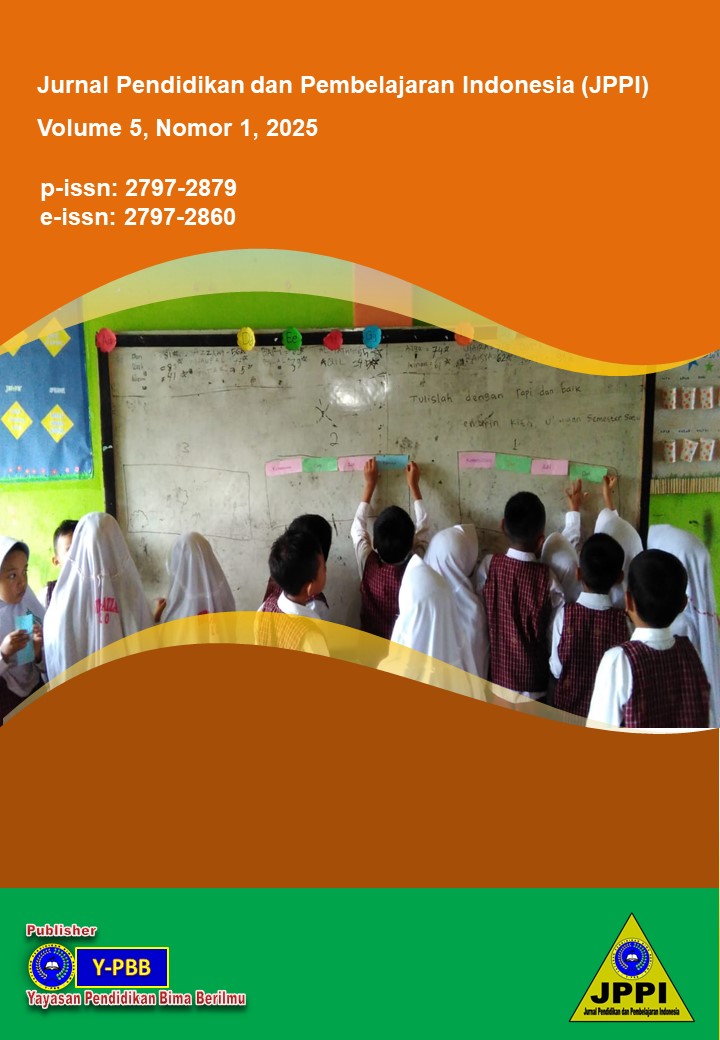Islamic Religious Education Teacher's Experience in Implementing Differentiated Learning
DOI:
https://doi.org/10.53299/jppi.v5i1.875Keywords:
Teacher, Islamic Religious Education, Differentiated LearningAbstract
The research aims to examine the response of Islamic Religious Education teachers' experiences in implementing differentiated learning in the classroom: a case study of SND INPRES Tololara. The focus of this research is how the experience of Islamic Religious Education teachers in implementing differentiated learning. Using a qualitative approach that emphasizes natural reality, and data collection techniques include observation, interviews, documentation, and data analysis techniques by reviewing the results in the collected data that detect topics and patterns that emerge. The results of this study indicate that Islamic Religious Education teachers in their experience to identify student needs use diagnostic assessment to find out the background of students. In the strategy of implementing differentiated learning, Islamic Education teachers use four aspects of learning, namely: content, process, product and learning environment. In his experience, Islamic Education teachers have challenges or obstacles, namely, lack of strategies, limited time and resources, the solution is to apply the four aspects above so that Islamic Education teachers can change learning according to their needs because everything is under the control of the teacher.
References
Abdussamad, Z. (2021). Metode Penelitian Kualitatif: CV. syakir Media Press.
Adisjam1, A. S. (2023). Penerapan pembelajaran diferensiasi mengoptimalkan minat dan bakat murid dalam pembelajaran pjok smp al azhar mandiri palu. MULTILATERAL: Jurnal Pendidikan Jasmani Dan Olahraga, 22(4), 54–61.
Ahmad Teguh Purnawanto, M. P. (2023). Pembelajaran Berdiferensiasi. Jurnal Ilmiah Pedagogy PEMBELAJARAN, 1(2), 34–54.
Amalia, K., Rasyad, I., Gunawan, A., & S. (2023). Differentiated Learning as Learning Innovation. Journal of Education and Teaching Learning (JETL), 5(2), 185–193.
Astria, R. T., Kusuma, A. B., Purwokerto, U. M., Berdiferensiasi, P., & Kreatif, K. B. (2023). Analisis Pembelajaran Berdiferensiasi Untuk Meningkatkan Kemampuan Berpikir Kreatif Matematis. Jurnal Penelitian Matematika Dan Pendidikan Matematika, 6(2), 112–119.
Dr. Marlina, S.Pd., M. S., & PANDUAN. (n.d.). Panduan Pelaksanaan Model Pembelajaran Berdiferensiasi di Sekolah Inklusif. Buku, 1–63.
Fitri, A. A., & Nani Solihati. (2023). Analisis Penerapan Pembelajaran Diferensiasi Proses Melalui Gaya Belajar Siswa Pada Materi Menulis Laporan Hasil Observasi. Semantik, 12(2), 221–232. https://doi.org/10.22460/semantik.v12i2.p221-232
Handiyani, M., Muhtar, T., Guru, P., Dasar, S., & Indonesia, U. P. (2022). Jurnal basicedu. 6(4), 5817–5826.
Himmah, F. I., & Nugraheni, N. (2023). Analisis Gaya Belajar Siswa untuk Pembelajaran Berdiferensiasi Analysis of Student Learning Styles for Differentiated Learning. 4(1), 31–39. https://doi.org/10.30595/jrpd.v4i1.16045
Kamila, C. A., Nur, H., & Yusuf, Z. (2024). Analisis Kesiapan Guru PAI dalam Implementasi Pembelajaran Berdiferensiasi di SMK Muhammadiyah 2 Malang. Jurnal PAI Raden Fatah, 6(4), 219–232.
Marzoan. (2023). Penerapan Pembelajaran Berdiferensiasi Di Sekolah Dasar. Renjana Pendidikan Dasar, 3(2), 113–122.
MS, M. (2023). Pembelajaran Berdiferesiasi Dan Penerapannya. SENTRI: Jurnal Riset Ilmiah, 2(2), 533–543.
Peduk, R. (2022). Strategi Pembelajaran Berdiferensiasi : PENERBIT CV.EUREKA MEDIA AKSARA. 1–23.
Pradoko, A. M. S. (2017). PARADIGMA PENELITIAN KUALITATIF (keilmuan seni, humaniora, dan budaya). Uny PRESS, 1–267. http://scioteca.caf.com/bitstream/handle/123456789/1091/RED2017-Eng-8ene.pdf?sequence=12&isAllowed=y%0Ahttp://dx.doi.org/10.1016/j.regsciurbeco.2008.06.005%0Ahttps://www.researchgate.net/publication/305320484_SISTEM_PEMBETUNGAN_TERPUSAT_STRATEGI_MELESTARI
Putra, H. T. P. J. R. S. (n.d.). Refleksi Diri Guru Bahasa Indonesia Dalam Pembelajaran Berdiferensiasi Di Sekolah Penggerak. Lingua Franca : Jurnal, Sastra, Dan, Pengaaranya, 224–232.
Raco, J. R. (2010). METODE PENELlTlAN KUALlTATlF: JENIS, KARAKTERISTIK, DAN KEUNGGULANNYA. PT Grasindo, 146.
Sarnoto, A. Z. (2024). Model Pembelajaran Berdiferensiasi Dalam Kurikulum Merdeka. Journal on Education, 06(03), 15928–15939.
Siti Alfiyana Azizah1, & , Ali Usman2, Muhammad Ali Rif’an Fauzi3, E. R. (2023). Analisis Gaya Belajar Siswa Pembelajaran Berdeferensiasi dalam Menerapkan. JTP: Jurnal Teknologi Pendidikan, 1(2), 1–12.
Sukmawati, A. (2022). Alam Kurikulum Merdeka Pada Mata Pelajaran Pendidikan Agama Islam. EL BANAT, 12(117), 121–137.
Tiara Nove Ria, L. K. (2023). Pelatihan Pembelajaran Berdiferensiasi Bagi Guru-Guru Smpn 4 Demak. Jurnal Awam, 3(1), 13–18.
Wahyuningsari, D., Mujiwati, Y., Hilmiyah, L., Kusumawardani, F., & Sari, I. P. (2022). Pembelajaran Berdiferensiasi Dalam Rangka Mewujudkan Merdeka Belajar. Jurnal Jendela Pendidikan, 2(04), 529–535. https://doi.org/10.57008/jjp.v2i04.301
Yani, D., Muhanal, S., & Mashfufah, A. (2023). Implementasi Assemen Diagnostic Untuk Menentukan Profil Gaya Belajar Siswa Dalam Pembelajaran Diferensiasi Di Sekolah Dasar. Jurnal Inovasi Dan Teknologi Pendidikan, 1(3), 241–250. https://doi.org/10.46306/jurinotep.v1i3.27
Downloads
Published
Issue
Section
License
Copyright (c) 2025 Jurnal Pendidikan dan Pembelajaran Indonesia (JPPI)

This work is licensed under a Creative Commons Attribution 4.0 International License.














